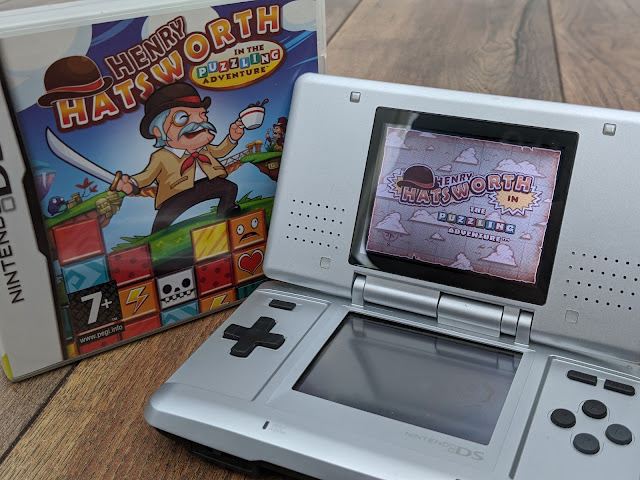Henry Hatsworth in The Puzzling Adventure for the DS
Previous days' entries can be read HERE
I was recently reading a review on Eurogamer of a Nintendo DS game called 'Scurge: Hive' (a cracking isometric Metroidvania), in which the writer was lamenting the fact that so many DS games only used the lower display as a map screen.
‘Henry Hatsworth in The Puzzling Adventure’ was developed by a team led by Kyle Gray, who later went on to co-found The Tomorrow Corporation; developers of 'World of Goo', 'Little Inferno', and 'Human Resource Machine'.
I don’t deny this is a fair point, but it is one mostly limited (luckily) to the sort of game I don’t really play.
I’m actually struggling to recall a game (other than 'Scurge: Hive', obviously) that didn’t have some practical or interesting use for the second screen. Even Sonic Rush (which I bounced off pretty hard on day 56) looked beautiful split across the dual screens, and now here’s 'Henry Hatsworth', the very next DS game I play, wherein the second screen is not just used well, but used to play almost a completely different game to that being played on the top.
This is a game that combines an action-platformer, played on the top screen, with a match-three puzzler, played on the bottom. And ‘combines’ is the correct word, it would have been easy for the two, very different, games to seem disjointed or only have a faint connection, but Hatsworth brilliantly manages to ensure that actions in one game directly affect events in the other.
‘Henry Hatsworth in The Puzzling Adventure’ was developed by a team led by Kyle Gray, who later went on to co-found The Tomorrow Corporation; developers of 'World of Goo', 'Little Inferno', and 'Human Resource Machine'.
Mr Gray, it seems, doesn’t get involved with bad video games.
The action platformer section of the game has our hero traversing 6 worlds in search of a magical golden suit once worn by ‘The Gentlemen’, the best dressed man in history.
Legend has it that only he was capable of wearing the suit and wielding its magical, world saving, power. Many others have tried, and all have failed. “Challenge,” says Mr Hatsworth, “Accepted”.
Not literally, of course, Henry Hatsworth is a man of class (and bluster) and wouldn’t lower himself to speak in such gauche terms.
The dapper old gent quickly discovers the first part of the suit, a bowler hat, and finds himself magically transformed from a grey haired retiree wielding an umbrella and wearing business attire, to dashing flame haired adventurer wielding a sword and decked out in a safari suit.
The art and animation depicting all this is very neatly done and very characterful, the animations are particularly impressive and remain so throughout the game.
Platforms are crossed, enemies are defeated, bosses are beaten - there’s nothing here that will blow your mind - but for the most part it’s a very good example of this type of game, with inspiration pulled from many of the genre classics.
Instant death from falling off the screen seems harsh in a game that has some huge knock-back (and an energy bar), and the downward attack has a really small hit zone, but these are small quibbles in an overall enjoyable and challenging adventure.
My biggest issue is that each world is made of six long levels with a boss fight at the end. The game is desperately in need of a mid-boss to break up the flow a bit.
As enemies are beaten during the course of Hatsworth’s adventure, they fall to the bottom of the screen where the match-three part of the game happens.
Of all the millions of examples of this genre, Henry Hatsworth’s take puts me most in mind of the mechanics of Zoo Keeper; whereby any two squares can be swapped left to right.
The screen scrolls upwards but there isn’t a fail state for the stack reaching the top, as the majority of the blocks are benign and will simply disappear.
However, when a defeated enemy falls into this game it turns into an aggressive block, which needs to be destroyed by including it in a match. If one reaches the top of the screen it returns to the platformer part of the game and makes a bloody nuisance of itself.
Careful management of the bottom screen is key to success in the top, but events and enemies will often throw a spanner in the carefully planned works to ensure it all stays dynamic and interesting.
I’m in danger of re-writing the manual here so I’ll summarise: Everything that happens in the top screen falls into the bottom to be destroyed (enemies) or activated (power-ups).
Activated power-ups are then given to Henry in the Platform game. It’s a brilliant, cyclical, mechanic that elevates two very good component parts to become one, single, great game.

No comments:
Post a Comment